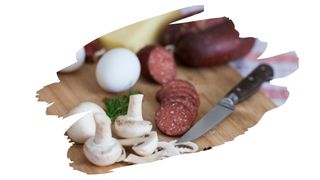Tung oil has been used for centuries to protect wood from water-damage. Extracted from Tung tree seeds, this water-resistant finish can be applied onto everything, from table tops to cabinets.
Now, one of the main reasons why Tung oil is so popular, is because it’s easy to apply. And, once it has cured, you’ll end up with a beautiful finish.
But, appearances aside, how does this clear oil stack up when it comes to being food safe?
Well, in this post, you will learn what really goes into a Tung oil finish. And you will find out why you must always double check the label of any so-called ‘Tung‘ oil product.
And keep reading to discover the best food safe oil you can use on a cutting board.

This post may contain affiliate links to products that we receive a commission for (at no additional cost to you). Learn more here.
What Is Tung Oil Made Of?
Tung oil is a natural oil, because it’s extracted from Tung tree seeds. And this oil, in its 100% pure form, doesn’t contain any hidden additives or chemical dryers.
However, according to the University of Florida Institute of Food And Agricultural Sciences, all parts of this tree are poisonous. Which would include the pure unfiltered oil extracted from this trees seeds.
So, Tung oil is not classed as a food-grade oil. That is because food grade oils, such as Raw Linseed oil, are safe for human consumption.
Can Tung Oil Make You Sick?
If consumed in its pure unfiltered liquid form, pure Tung oil can make you nausous. So, you do not want it getting into your food.
What’s more, not all Tung oil products on the market are even pure Tung oil. Many of them market themselves as such. Yet, unless the label specifically reads ‘100% Pure Tung oil’, that wood finish is likely anything but.
You see, these fake-Tung oil products are more like Teak oil in their makeup. They contain a blend of natural oils, chemical thinners, varnish and other additives. Some may contain a bit of Tung oil. Others, may not.
These fake-Tung oil products are also very poisonous in their liquid form. Which is why you should make sure they never make their way onto your dinner plate.
Related Post: Can You Use Tung Oil On Cherry Wood? (Avoid These 3 Simple Mistakes)
What About When It Dries? Is A Dried Tung Oil Finish Safe To Eat Off?
Provided that Tung oil finish has dried and cured, then it is safe enough to eat off. However, the key word here is ‘cured’.
A dry oil finish is one that has turn from a liquid into a solid, (yet still soft to the touch), film coat. This film coat can still feel a little greasy. So, in this dry state, (which takes Tung oil around 1-2 days to achieve), it is not a food safe surface.
However, a cured oil finish is one that has changed into a durable hard resinous coat. It takes Tung oil much longer to cure, up to around 30 days.
Yet once Tung oil has cured, there are no greasy spots, and no softness to the finish. This cured surface is food safe enough to eat your dinner off of.
But, that does not mean Tung oil is suitable for a food prepping surface.
Is Tung Oil Safe For A Cutting Board Or Butcher Block?
There are a couple of good reasons to skip over Tung oil for your cutting board:
1). It Takes Ages To Cure
After you seal your board with Tung oil, you must wait for the finish to wholly cure before you use that board. That means your cutting board will be out of commission for weeks.
However, the secret to Tung oils time-honored water-resistance, lies in its ‘build-up’. Repeated reapplication of this natural oil finish is where the magic happens.
The increasing Tung oil coats added to wood (over time) makes wood ever more water-resistant. Especially as it overlays the previous Tung oil coat. So applying a Tung oil finish is not a once-and-done deal.
Which is why Tung oil needs to be reapplied every 6-12 months. Especially if that wood happens to be regularly drenched with water.
And the waiting-around-for-it-to-cure timer will start all over again, after you reapply it.
2). It It Not A Food Grade Finish
The way we use cutting boards involves chopping, slicing and dicing. Which means that little bits of Tung oil resin could get into your food.
Its fine to place food upon a cured solid Tung oil finish. However, you do not want this finish getting into your actual food, all the same.
This is why Tung oil isn’t suitable for a cutting board. If you want to seal cutting boards, you should be using a food grade wood finish.
So, What Kind Of Food Safe Oil Can You Use On A Chopping Block?
By far, 100% pure food grade mineral oil is your best and safest option for any cutting board.
This non-drying oil is a non-toxic highly refined version of petroleum, (also known as petroleum distillate). This petroleum product has been filtered to within an inch of its life, making it safe for human consumption.
But, What Makes Mineral Oil A Great Wood Finish?
Mineral oil protects wood in a similar way to Tung oil. Both oil finishes sink into wood grain, and coat wood fibers with a water-repellent liquid. This will stop wood fibers from absorbing moisture, preventing wood rot and decay.
But, mineral oil is much easier to apply (and reapply) than Tung oil. You don’t need to wait around for it to dry and cure. And it doesn’t need multiple coats to fully saturate cutting board timber either.
You can find 100% pure food grade mineral oil on most any local pharmacy shelf. But, full disclosure, this stuff is typically sold as a laxative. So, be prepared to get the odd funny look, if you decide to buy this stuff by the gallon. 🙂
To Wrap Up, Here Are The 3 Key Takeaways From This Post…
- 1). Tung oil comes from the seeds of Tung trees.
- 2). After a Tung oil finish is cured, it becomes a food safe surface. It is not, however, a food grade finish.
- 3). However, Tung oil isn’t suitable for a chopping block. Instead, use a food grade wood finish, such as 100% pure food grade mineral oil.
References:
Tung Seed – Uses, Side Effects, and More | WebMD.com
Vernicia fordii (Tung oil tree) | University of Florida Institute of Food And Agricultural Sciences
Updated 15th Nov 2022



